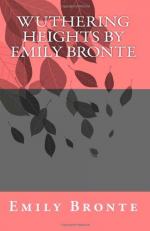|
This section contains 548 words (approx. 2 pages at 400 words per page) |

|
Narration
The power of Wuthering Heights owes much to its complex narrative structure and to the ingenious device of having two conventional people relate a very unconventional tale. The story is organized as a narrative within a narrative, or what some critics call "Chinese boxes." Lockwood is used to open and end the novel in the present tense, first person ("I'). When he returns to Thrushcross Grange from his visit to Wuthering Heights sick and curious, Nelly cheerfully agrees to tell him about his neighbors. She picks up the narrative and continues it, also in the first person, almost until the end, with only brief interruptions by Lockwood. The critic David Daiches notes in his introduction of Wuthering Heights the "fascinating counterpoint" of "end retrospect and present impression," and that the strength of the story relies on Nelly's familiarity with the main characters.
Setting
The novel is set in...
|
This section contains 548 words (approx. 2 pages at 400 words per page) |

|




